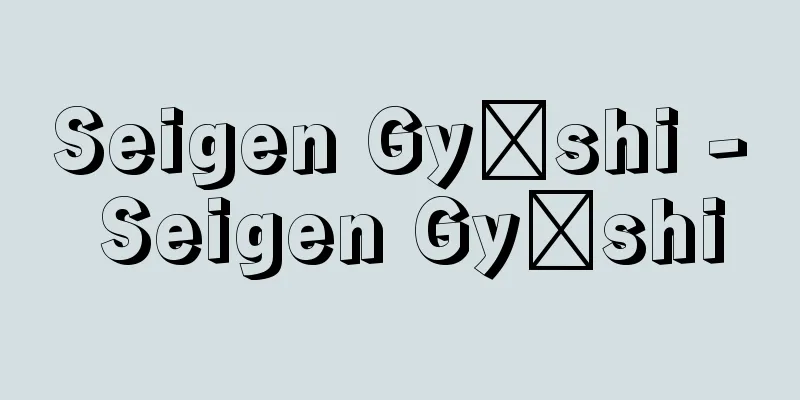Suminokura Soan

|
Year of death: June 22, 1632 (August 7, 1632) Year of birth: 1571.6.27 A wealthy merchant and cultural figure in Kyoto in the early modern period. His father was Suminokura Ryoi and his mother was Yoshida Eika's daughter. He was commonly known as Yoichi (the main Suminokura family in Nijo, Kyoto, has called him Yoichi for generations). His given name was Genno, later Teijun, and his pen name was Komoto. In 1588, he met Fujiwara Seika, and was influenced by Seika's scholarship, becoming a scholar of Confucianism in broad terms. He also came to know Hayashi Razan, and played an important role in the history of Confucianism in Japan, such as introducing Seika to Razan. Seika trusted him, and instructed him to edit down the 100-plus volumes of "Monjo Tattokuroku" and its principles (a collection of poetry, stories, and writings from ancient and modern times), which became one of his life's work. He also became friends with Honami Koetsu around this time, and learned calligraphy from Koetsu. He later became one of the "Three Calligraphers of the Kan'ei Era" along with Koetsu. With the help of Koetsu and others, and thanks to the wealthy environment of Suminokura, in 1599 Soan published the Records of the Grand Historian, followed by many other classic works, including an elegant edition known as the Sagabon. This publication continued until around 1602, and became a memorable achievement for future generations. Meanwhile, during this time Soan assisted his father Ryoi in his red seal ship trade with Annamoku Tokyo (Indochina Peninsula) from 1605, taking on responsible roles as the Annamoku ambassador and succeeding the red seal ship trade. He also devoted himself to his father's work as a good assistant, working on the difficult construction projects his father had been carrying out, such as the excavation of the Oi River, the construction of a canal on the Fuji River, and the construction of canals on the Tenryu River, the Kamo River Channel, and the Takase River. By order of the shogunate, Soan was ordered to patrol mines in Kai (Yamanashi Prefecture), Izu (Shizuoka Prefecture), and other areas from 1618 to 1619, and during the Siege of Osaka (1614-15) he made distinguished contributions to the transportation of military supplies on rivers such as the Yodo River. In 1615, he was ordered by the shogunate to control the Takase ships and the ships passing through the Yodo River, and he also became a magistrate in Yamashiro (Kyoto Prefecture). However, around 1616, he fell ill with an incurable disease and retired from public office and the family business. Driven by his natural love of learning, he spent the rest of his life devoted to academic research. In 1627, he divided his fortune among his sons and retired to a life of seclusion, taking with him his own collection of several thousand volumes of books. He is buried at Nenbutsu-ji Temple and Nison-in Temple in Kyoto City. His posthumous works include "Kienshu" and "Hyakkashu," but they are not known to this day. <References> "Kumokura Source Genealogy Draft" (owned by Heikichi Kumokura, Kyoto), "Kumokura Documents" (owned by Takanawa Museum of Art) (Yasunao Nakata) Source: Asahi Japanese Historical Biography: Asahi Shimbun Publications Inc. About Asahi Japanese Historical Biography |
|
没年:寛永9.6.22(1632.8.7) 生年:元亀2.6.5(1571.6.27) 近世初期の京都の豪商で文化人。父角倉了以,母吉田栄可の娘の長男。通称与一(京都二条の角倉本家では代々与一を称する)。諱は玄之のち貞順,字は子元。天正16(1588)年藤原惺窩に面接,惺窩の学識の感化を受け,儒学への広範な学究者となり,林羅山をも知り,惺窩に羅山を引き合わせるなど,日本儒学史上の重要な役割を果たした。惺窩に信頼され,その『文章達徳録』百余巻および綱領(惺窩自ら古今の詩話文章を集めたもの)の削補に取り組むように指示され,これが生涯の仕事のひとつになった。このころ本阿弥光悦とも親交があり,光悦より書を習得,のちに光悦と共に「寛永の三筆」のひとりとされた。光悦らの協力によって,角倉の富裕な環境にあったこともあって慶長4(1599)年,『史記』の刊行を始め,以後古典の数々の刊行を行い,嵯峨本と称される典雅な刊本が素庵によって版行された。この刊行は同15年ごろまで続けられ,後世に残る業績となった。一方,この間,素庵は慶長8年から父了以の安南国東京(インドシナ半島)との朱印船貿易に協力,自ら安南国回易大使として責任ある活動を行い,朱印船貿易を継承した。また父が行っていた大堰川の開削,富士川の疏通,天竜川,鴨川水道,高瀬川の運河の難工事など,父のよき補佐役として事業に専念した。素庵は幕命により同11年から同14年に甲斐(山梨県),伊豆(静岡県)などの鉱山の巡視を命ぜられ,大坂の陣(1614~15)には,淀川など河川運輸面で軍需物資の運搬に貢献し,功労があった。元和1(1615)年には幕府より高瀬船,淀川過書船支配を命ぜられ,また山城(京都府)の代官職についたが,同7年ごろに不治の病におかされ,公職や家業から引退し,生来の好学心から,学問研究に余生を送った。寛永4(1627)年息子らに財産を分与し,自ら数千巻の蔵書をもって隠棲。墓は京都市念仏寺および二尊院にある。遺著に『期遠集』『百家集』があるが今日伝わらない。<参考文献>「角倉源流系図稿」(京都角倉平吉氏蔵),「角倉文書」(高輪美術館蔵) (中田易直) 出典 朝日日本歴史人物事典:(株)朝日新聞出版朝日日本歴史人物事典について 情報 |
<<: Ryoi Suminokura - Ryoi Suminokura
>>: Prince Sumiyoshi - Prince Sumiyoshi
Recommend
Heck, P. von (English spelling) HeckPvon
…By exploring “living law” through empirical scie...
Giant centipede (giant centipede) - Giant centipede (English spelling)
A general term for arthropods belonging to the ord...
Mountain climbing school - Yamato
A school of Yamada-ryu koto music. It includes the...
criblé (English spelling) crible
…There are two types of woodblock printing: woodb...
Kunama
…The subdivisions are (1) Songhai, Songhai (Djerm...
Kaimur Mountains - Kaimursanchi
...a mountain range that crosses almost the entir...
Curacao [island] - Curacao
Until 2010, this was the largest island in the Net...
Fortune telling at a crossroads - Tsujiura
Also called Yuuke or Michiura. It is the act of g...
al-Ḥākim, Abū `Alī Manṣūr
[Raw] 985 [Died] February 13, 1021. He was the six...
Family movies
...This was the result of Kodak's standards s...
Beaune (English spelling)
A town in the Côte d'Or department in central-...
Cornet alacreme (English: Cornet alacreme)
...Add the flour and mix lightly, then transfer t...
Es Souk (English spelling)
…The oldest carvings, of elephants and hippos, ar...
Insurance salesperson
A person who belongs to a life insurance company a...
Anti-Japanese Salvation Association - Anti-Japanese Salvation Association
A general term for popular groups formed between 1...









